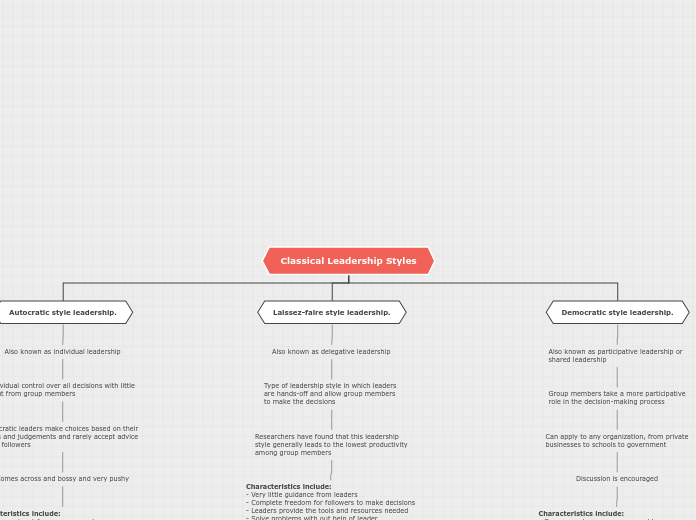
Also known as individual leadership
Individual control over all decisions with little
input from group members
Autocratic leaders make choices based on their
ideas and judgements and rarely accept advice
from followers
Comes across and bossy and very pushy
Characteristics include:
- Little or no input from group members
- Leaders make almost all of the decisions
- Group leaders dictate all the work methods and processes
- Group members are rarely trusted with decisions or
important tasks
- Work tends to be highly structured and very rigid
- Creativity and out-of-the box thinking tend to be
discouraged
- Rules are important and tend to be clearly outlined and
communicated
Pros
- Can make decisions quickly,
especially in stress-filled situations
- Clear chain of command,
oversight
- Good where strong, directive
leadership is needed
Cons
- Discourages group input
- Can impair morale and
lead to resentment
- May impair or ignore creative
solutions and expertise from
subordinates
Also known as delegative leadership
Type of leadership style in which leaders
are hands-off and allow group members
to make the decisions
Researchers have found that this leadership
style generally leads to the lowest productivity
among group members
Characteristics include:
- Very little guidance from leaders
- Complete freedom for followers to make decisions
- Leaders provide the tools and resources needed
- Solve problems with out help of leader
- Power is handed to followers yet leader is still in
charge
Pros
- Can work for motivated teams
with high expertise and skills
- Creative teams may value the
independence
- Works well when leader provides
needed information and materials
at start of project
Cons
- Not good for groups lacking
needed skills, motivation,
adherence to deadlines
- Can result in poor performance
and outcomes
- Leader may appear uninvolved
- Confusion over roles in the group
Also known as participative leadership or
shared leadership
Group members take a more participative
role in the decision-making process
Can apply to any organization, from private
businesses to schools to government
Discussion is encouraged
Characteristics include:
- Group members are encouraged to
share ideas and opinions, even though
the leader retains the final say over decisions.
- Members of the group feel more
engaged in the process.
- Creativity is encouraged and rewarded.
Pros
- More ideas and creative solutions
- Group member commitment
- High productivity
Cons
- Communication failures
- Poor decision-making by unskilled groups
- Minority or individual opinions overridden